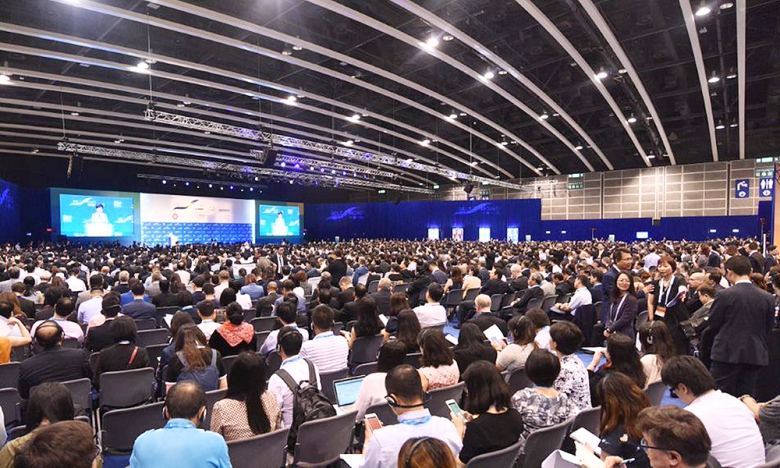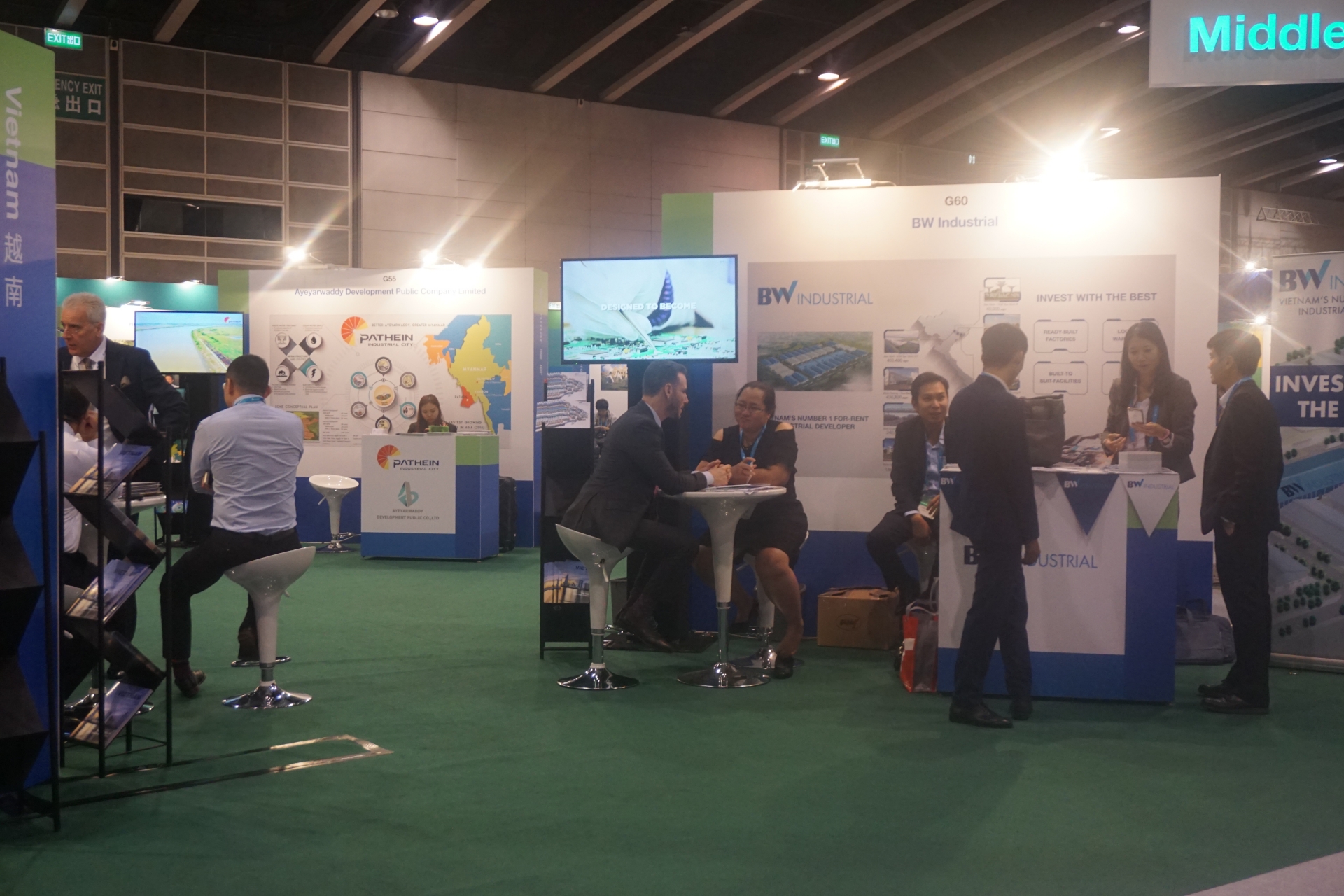Opportunities for Hong Kong and Vietnam under Belt and Road Initiative
 |
| The third Belt and Road Summit welcomed some 5,000 participants from 55 countries and regions at the Hong Kong Convention and Exhibition Centre on June 28 |
ASEAN—the logical first stop for Chinese investors
The Belt and Road Initiative (BRI) refers to the Silk Road Economic Belt and the 21st Century Maritime Silk Road initiatives. The network connects Asia, Europe, and Africa, and passes through more than 65 countries and regions with a population of about 4.4 billion, making up a third of the global economy.
According to Bernard Charnwut Chan, president of Asia Financial Holdings Ltd., BRI has been gaining traction after its launch in 2013. In the last two years, more Chinese companies have been looking to invest in BRI-related countries. The logical first stop for Chinese investors is the ASEAN, he said, due to the historical connections and relations.
As a Hong Kong-based firm, Asia Financial has been investing in both China and ASEAN markets for years. The firm has recently helped a Chinese corporation extend its reach to the ASEAN region. It is just one example of the significant role Hong Kong plays in the development of BRI as well as in connecting China with the world.
Indeed, Hong Kong and the ASEAN are expected to enjoy deeper economic ties, following the recently-signed ASEAN-Hong Kong Free Trade Agreement (AHKFTA). Jimmy Chiang, associate director general of investment promotion at Invest Hong Kong, told VIR that the free trade agreement will give Hong Kong-based multinationals and companies many opportunities to tap into ASEAN countries, including Vietnam.
Specifically, customs duties on goods originated from Hong Kong will be reduced or even eliminated once the AHKFTA comes into force. There will be fewer restrictions on Hong Kong service providers, with examples including the cap on foreign ownership being raised to over 50 per cent in many sectors of the ASEAN markets. There will be fair treatment of Hong Kong investment and enhanced protection against non-commercial risks.
According to Chiang, Hong Kong is a free port with no general tariff on imported goods. With the AHKFTA in place, international companies can enjoy tax reductions within the ASEAN to move products to the region. Also, lower barriers are expected to facilitate Hong Kong-based companies to develop service businesses in the ASEAN. Thus, the AHKFTA will attract more international companies to use Hong Kong as a platform to enter ASEAN markets like Vietnam.
Hong Kong is regarded as one of the world’s freest economies, with strong financial and professional service sectors. The city is the most suitable location for a commercial hub for BRI projects.
Meanwhile, the ASEAN was the second-largest export market for Hong Kong in 2017 after mainland China. Vietnam was among the top three markets for products from Hong Kong among ASEAN member states last year, accounting for 30.7 per cent of Hong Kong's total exports to the ASEAN.
Vietnam stands to benefit
According to a report by consultancy firm Baker McKenzie, Vietnam is already tightly integrated into China’s supply chain. However, there are still huge opportunities for further improvement in road and rail links, all underpinned by robust commercial activity.
China Railway partnered with Vietnam Railways to launch a container block train connecting Huanggang Station in Nanchang and Yen Vien Station in Hanoi last November. This was the first container block train linking the two countries.
CFLD Vietnam Real Estate Development, a subsidiary of China Fortune Land Development, also tied up with Vietnam’s Tin Nghia Corporation to develop the East Saigon Urban Area and Ong Keo Industrial Zone in the southern province of Dong Nai. Both projects are located near Long Thanh International Airport, which will take shape in the near future.
On the other hand, BRI also brings new opportunities for multinationals investing in Vietnam. According to Greg Ohan, deputy CEO of BW Industrial Development, as a potential catalyst for greater connectivity, BRI will facilitate manufacturing and cross-border trade in the region. This is no surprise given Vietnam’s proximity to China and strategic position in the ASEAN, which will open up more opportunities for the country in general and BW Industrial in particular.
“BRI is a contributor to our business, mainly on the back of infrastructure improvement. With improving roads, ports, airports, and seaports, manufacturers can get their goods in and out of Vietnam more easily. That is where we see the opportunities and benefits for our ‘for-rent’ industrial and logistics business in the country,” he added.
Canada-based Vision Transportation Group, specialising in the development of infrastructure projects, is currently seeking strategic partners from China to diversify its portfolio in Vietnam.
According to Richard Courey, the firm’s chairman and CEO, the time is ripe for international companies, including those from China, to develop infrastructure projects in Vietnam. The Vietnamese government has recently adopted Decree No.63/2018/ND-CP, which clarifies and improves the possibility of investment under the public-private partnership model.
“This legal framework provides a tool that enables foreign investors to implement major infrastructure developments across Vietnam. Meanwhile, funds are available from various markets like China and Hong Kong. This is an opportunity for Vietnam to capture the benefits of economic growth associated with a national programme of infrastructure development,” he said.
 |
| Vietnam-based multinationals and companies explore new opportunities and look for potential partners at the third Belt and Road Summit in Hong Kong |
What the stars mean:
★ Poor ★ ★ Promising ★★★ Good ★★★★ Very good ★★★★★ Exceptional
Related Contents
Latest News
More News
- First members of Danang International Finance Centre revealed (December 22, 2025 | 17:39)
- Securing capital and efficiency for Vietnam’s 2026-2030 growth ambitions (December 17, 2025 | 10:00)
- Driving double-digit growth through green and circular transformation in Vietnam (December 17, 2025 | 09:00)
- Vietnam bucking trend in the global M&A landscape (December 16, 2025 | 14:20)
- Vietnam’s green transition demands collective financial action (December 15, 2025 | 12:00)
- VIR workshop highlights capital and policy for sustainable development (December 15, 2025 | 11:00)
- National Assembly approves pilot mechanisms to accelerate major projects in Hanoi (December 12, 2025 | 11:29)
- Vietnam eases policy approval requirements, simplifies foreign and outbound investments (December 11, 2025 | 17:53)
- Unpacking new momentum in Vietnam’s M&A market (December 10, 2025 | 09:59)
- Forum honours outstanding M&A deals, strategies, and advisory firms (December 09, 2025 | 18:22)

 Tag:
Tag:





















 Mobile Version
Mobile Version